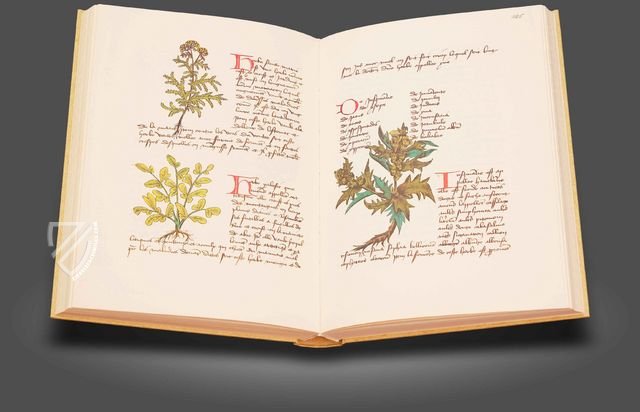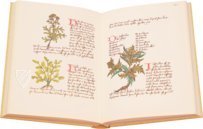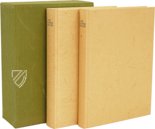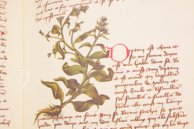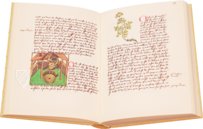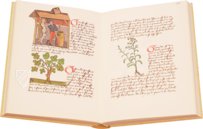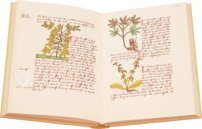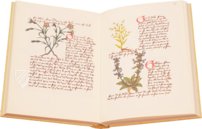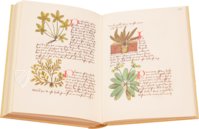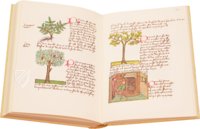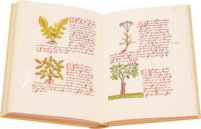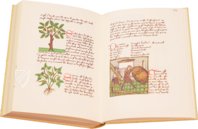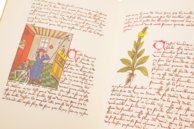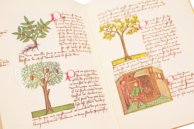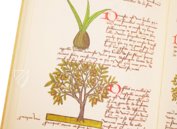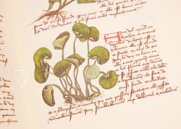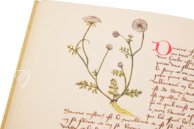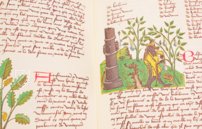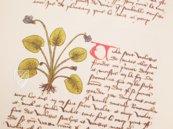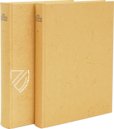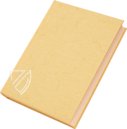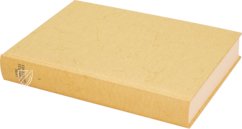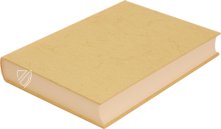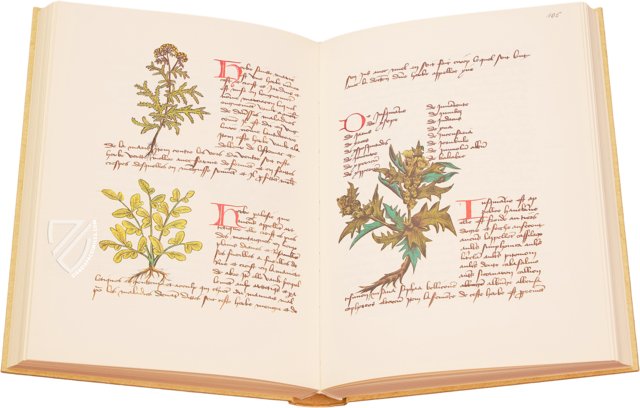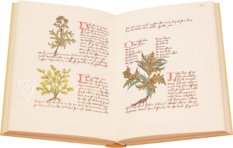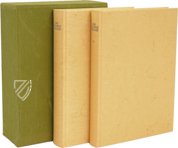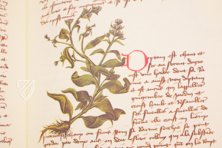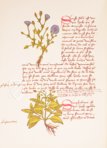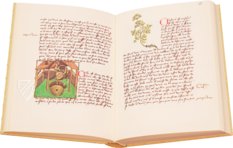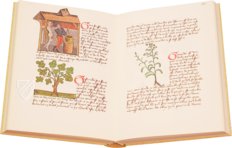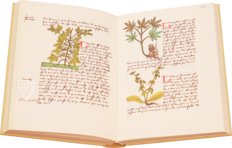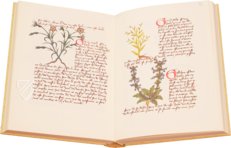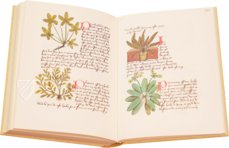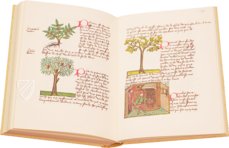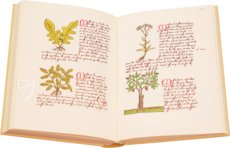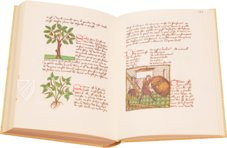Book of Simple Medicines - Codex Bruxellensis
Originally written in Latin by Matthaeus Platearius during the 12th century under the title Circa Instans, the Book of Simple Medicines enjoyed widespread popularity over the coming centuries and was translated into France under the title Le Livre des simples medecines. Named after its home in Belgium, the Codex Bruxellensis IV is a late-15th century manuscript of this major medieval pharmacopeia. It was written on paper in an elegant cursive script by a skilled hand using maroon ink. A total of 457 naturalistic miniatures adorn the alphabetical list of “simples” – unadulterated vegetable, mineral, or animal products with medicinal applications. The work of Platearius is appended here with knowledge from additional sources like the famous Arab physician ibn Butlan. Unlike other manuscripts, which merely copied illustrations from earlier works, the miniatures of the Codex Bruxellensis IV appear to be based on the artists’ direct observation of nature, making it stand out among the two dozen surviving manuscript copies of the pharmacopeia.
Book of Simple Medicines - Codex Bruxellensis
Matthaeus Platearius, a physician trained at Salerno’s famous medical school, built on the works of Pliny and Dioscorides and blended them with more contemporary texts to create the Circa Instans or “Book of Simple Medicines”. This 12th century text was highly acclaimed during the Middle Ages and considered the equal of the herbals of the aforementioned ancient scholars. This manuscript is essentially an illustrated encyclopedia of 15th century medicine in the West consisting of a translation of the Tractatus de herbis by Bartholomew Mini of Siena, which was itself based on Platearius’ Circa instans, the pseudo-Apuleius, De virtutibus herbarum, Livre des secres de nature, and was subsequently supplemented with Arabic sources like Ibn Butlan’s Tacuinum sanitates. It is presented in a manuscript originating from France ca. 1480 that is furnished by 457 naturalistic and colorful miniatures: 394 botanical, 10 animal, 11 mineral, and 42 others.
A Mother’s Wisdom
Most people in the Middle Ages, from the highest social strata to the lowest, followed in the footsteps of their fathers professionally-speaking, or in the case of Matthaeus Platearius and his brother Johannes, their mother: Trota of Salerno. She is the author of numerous works on women’s medicine and health including one of the three texts in the so-called Trotula, which is named after her. She became famous across Europe from Sicily to England and some of her works were rediscovered during the 20th century, leading to a renewal of scholarly interest in her. While educated at the Schola Medica Salernitana, she specialized in women’s reproductive health and childbirth, making her arguably the world’s first gynecologist. Trota went on to teach as a professor and shared her knowledge with a generation of gynecologists who in turn spread it across the western world. She also wrote texts on personal health, diet, and hygiene recommending exercise, a good diet, and avoiding stress. These principles also lie at the heart of the Circa Instans and Matthaeus Platearius must surely have been heavily influenced by his wise and famous mother.
Codicology
- Alternative Titles
- Buch der einfachen Heilmittel - Codex Bruxellensis
Livre des Simples Medecines: Codex Bruxellensis
Codex Bruxellensis IV. 1024
Book of Simple Medicines
Buch der einfachen Heilmittel
Livre des Simples Medecines - Size / Format
- 466 pages / 29.0 × 21.2 cm
- Origin
- France
- Date
- Second half of the 15th century
- Epochs
- Style
- Language
- Script
- French littera bastarda
- Illustrations
- 461 miniatures, thereof 394 plant depictions, 10 animal images, 11 illustrations of minerals, and 46 others
- Content
- French pharmacopoeia
- Artist / School
- Matthaeus Platearius (12th century)
Book of Simple Medicines - Codex Bruxellensis
Balsamin
This colorful, scenic miniature not only depicts the plant described, but also focuses on its geographical habitat and the extraction of the valuable balm obtained from it. Referring to the famous writings of Dioscorides, the text locates Balsamin, known to us today as Commiphora gileadensis or Arabian Balsam Tree, in a region near Babylon with seven springs – three of which can also be seen in the miniature, while the tower, starting to fall into ruin, is probably meant to represent the biblical city. In the foreground, a Black, bearded person in a splendid yellow robe ties a vial to one of the balsam trees. The text explains that the balsam is extracted in a similar way to resin, through cuts made in the branches, from which the balsam flows into the vials. It is described as a yellowish, clear liquid that both preserves corpses and helps against a wide variety of “abdominal complaints” – from inducing a stillbirth to expelling bladder stones. It is also said to relieve toothache when put into the ear on the painful side and to make scars disappear.
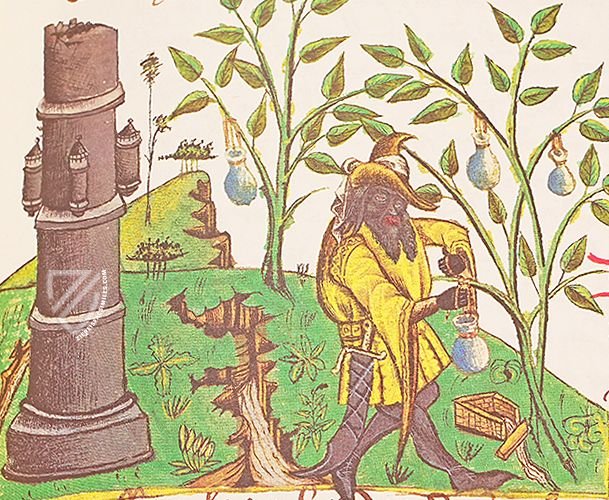
Book of Simple Medicines - Codex Bruxellensis
Common Chicory and Figwort
Like most plant depictions, the two illustrations on this page have been painted without a background or frame in the designated spaces. Both plants are shown with their roots, which has been typical of medical-botanical herbariums since ancient times.
The upper miniature shows the common chicory with its charming blue flowers made up of many narrow petals. In the text, it is referred to by the poetic Latin name “Sponsa solis,” which means “bride of the sun” and is an old, popular name for the plant. It was already used in the Middle Ages both as a medicinal plant and as food. The Latin name of the figwort shown below, “Scrophulavia,” is derived from its medicinal use in the Middle Ages: among other things, it was used to treat scrofula.
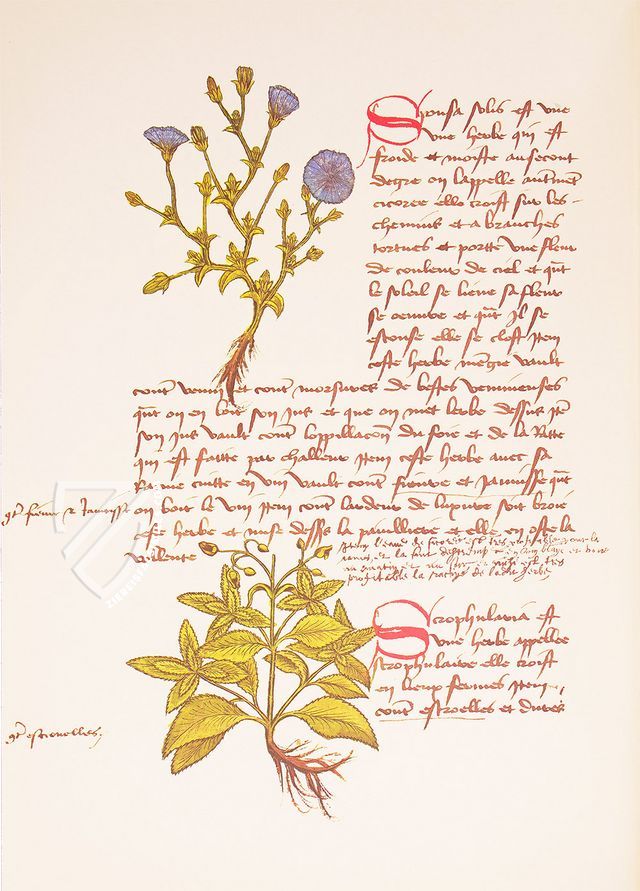
#1 Livre des Simples Medecines: Codex Bruxellensis IV. 1024
Language: English
- Treatises / Secular Books
- Apocalypses / Beatus
- Astronomy / Astrology
- Bestiaries
- Bibles / Gospels
- Chronicles / History / Law
- Geography / Maps
- Saints' Lives
- Islam / Oriental
- Judaism / Hebrew
- Single Leaf Collections
- Leonardo da Vinci
- Literature / Poetry
- Liturgical Manuscripts
- Medicine / Botany / Alchemy
- Music
- Mythology / Prophecies
- Psalters
- Other Religious Books
- Games / Hunting
- Private Devotion Books
- Other Genres
- Afghanistan
- Armenia
- Austria
- Belgium
- Belize
- Bosnia and Herzegovina
- China
- Colombia
- Costa Rica
- Croatia
- Cyprus
- Czech Republic
- Denmark
- Egypt
- El Salvador
- Ethiopia
- France
- Germany
- Greece
- Guatemala
- Honduras
- Hungary
- India
- Iran
- Iraq
- Israel
- Italy
- Japan
- Jordan
- Kazakhstan
- Kyrgyzstan
- Lebanon
- Liechtenstein
- Luxembourg
- Mexico
- Morocco
- Netherlands
- Palestine
- Panama
- Peru
- Poland
- Portugal
- Romania
- Russia
- Serbia
- Spain
- Sri Lanka
- Sweden
- Switzerland
- Syria
- Tajikistan
- Turkey
- Turkmenistan
- Ukraine
- United Kingdom
- United States
- Uzbekistan
- Vatican City
- A. Oosthoek, van Holkema & Warendorf
- Aboca Museum
- Ajuntament de Valencia
- Akademie Verlag
- Akademische Druck- u. Verlagsanstalt (ADEVA)
- Aldo Ausilio Editore - Bottega d’Erasmo
- Alecto Historical Editions
- Alkuin Verlag
- Almqvist & Wiksell
- Amilcare Pizzi
- Andreas & Andreas Verlagsbuchhandlung
- Archa 90
- Archiv Verlag
- Archivi Edizioni
- Arnold Verlag
- ARS
- Ars Magna
- ArtCodex
- AyN Ediciones
- Azimuth Editions
- Badenia Verlag
- Bärenreiter-Verlag
- Belser Verlag
- Belser Verlag / WK Wertkontor
- Benziger Verlag
- Bernardinum Wydawnictwo
- BiblioGemma
- Biblioteca Apostolica Vaticana (Vaticanstadt, Vaticanstadt)
- Bibliotheca Palatina Faksimile Verlag
- Bibliotheca Rara
- Boydell & Brewer
- Bramante Edizioni
- Bredius Genootschap
- Brepols Publishers
- British Library
- C. Weckesser
- Caixa Catalunya
- Canesi
- CAPSA, Ars Scriptoria
- Caratzas Brothers, Publishers
- Carus Verlag
- Casamassima Libri
- Centrum Cartographie Verlag GmbH
- Chavane Verlag
- Christian Brandstätter Verlag
- Circulo Cientifico
- Club Bibliófilo Versol
- Club du Livre
- CM Editores
- Collegium Graphicum
- Collezione Apocrifa Da Vinci
- Comissão Nacional para as Comemorações dos Descobrimentos Portugueses
- Coron Verlag
- Corvina
- CTHS
- D. S. Brewer
- Damon
- De Agostini/UTET
- De Nederlandsche Boekhandel
- De Schutter
- Deuschle & Stemmle
- Deutscher Verlag für Kunstwissenschaft
- DIAMM
- Droz
- E. Schreiber Graphische Kunstanstalten
- Ediciones Boreal
- Ediciones Grial
- Ediclube
- Edições Inapa
- Edilan
- Editalia
- Edition Deuschle
- Edition Georg Popp
- Edition Leipzig
- Edition Libri Illustri
- Editiones Reales Sitios S. L.
- Éditions de l'Oiseau Lyre
- Editions Medicina Rara
- Editorial Casariego
- Editorial Mintzoa
- Editrice Antenore
- Editrice Velar
- Edizioni Edison
- Egeria, S.L.
- Eikon Editores
- Electa
- Emery Walker Limited
- Enciclopèdia Catalana
- Eos-Verlag
- Ephesus Publishing
- Ernst Battenberg
- Eugrammia Press
- Extraordinary Editions
- Fackelverlag
- Facsimila Art & Edition
- Facsimile Editions Ltd.
- Facsimilia Art & Edition Ebert KG
- Faksimile Verlag
- Feuermann Verlag
- Folger Shakespeare Library
- Franco Cosimo Panini Editore
- Friedrich Wittig Verlag
- Fundación Hullera Vasco-Leonesa
- G. Braziller
- Gabriele Mazzotta Editore
- Gebr. Mann Verlag
- Gesellschaft für graphische Industrie
- Getty Research Institute
- Giovanni Domenico de Rossi
- Giunti Editore
- Graffiti
- Grafica European Center of Fine Arts
- Guido Pressler
- Guillermo Blazquez
- Gustav Kiepenheuer
- H. N. Abrams
- Harrassowitz
- Harvard University Press
- Helikon
- Hendrickson Publishers
- Henning Oppermann
- Herder Verlag
- Hes & De Graaf Publishers
- Hoepli
- Holbein-Verlag
- Houghton Library
- Hugo Schmidt Verlag
- Idion Verlag
- Il Bulino, edizioni d'arte
- ILte
- Imago
- Insel Verlag
- Insel-Verlag Anton Kippenberger
- Instituto de Estudios Altoaragoneses
- Instituto Nacional de Antropología e Historia
- Introligatornia Budnik Jerzy
- Istituto dell'Enciclopedia Italiana - Treccani
- Istituto Ellenico di Studi Bizantini e Postbizantini
- Istituto Geografico De Agostini
- Istituto Poligrafico e Zecca dello Stato
- Italarte Art Establishments
- Jan Thorbecke Verlag
- Johnson Reprint Corporation
- Josef Stocker
- Josef Stocker-Schmid
- Jugoslavija
- Karl W. Hiersemann
- Kasper Straube
- Kaydeda Ediciones
- Kindler Verlag / Coron Verlag
- Kodansha International Ltd.
- Konrad Kölbl Verlag
- Kurt Wolff Verlag
- La Liberia dello Stato
- La Linea Editrice
- La Meta Editore
- Lambert Schneider
- Landeskreditbank Baden-Württemberg
- Leo S. Olschki
- Les Incunables
- Liber Artis
- Library of Congress
- Libreria Musicale Italiana
- Lichtdruck
- Lito Immagine Editore
- Lumen Artis
- Lund Humphries
- M. Moleiro Editor
- Maison des Sciences de l'homme et de la société de Poitiers
- Manuscriptum
- Martinus Nijhoff
- Maruzen-Yushodo Co. Ltd.
- MASA
- Massada Publishers
- McGraw-Hill
- Metropolitan Museum of Art
- Militos
- Millennium Liber
- Müller & Schindler
- Nahar - Stavit
- Nahar and Steimatzky
- National Library of Wales
- Neri Pozza
- Nova Charta
- Oceanum Verlag
- Odeon
- Orbis Mediaevalis
- Orbis Pictus
- Österreichische Staatsdruckerei
- Oxford University Press
- Pageant Books
- Parzellers Buchverlag
- Patrimonio Ediciones
- Pattloch Verlag
- PIAF
- Pieper Verlag
- Plon-Nourrit et cie
- Poligrafiche Bolis
- Presses Universitaires de Strasbourg
- Prestel Verlag
- Princeton University Press
- Prisma Verlag
- Priuli & Verlucca, editori
- Pro Sport Verlag
- Propyläen Verlag
- Pytheas Books
- Quaternio Verlag Luzern
- Reales Sitios
- Recht-Verlag
- Reichert Verlag
- Reichsdruckerei
- Reprint Verlag
- Riehn & Reusch
- Roberto Vattori Editore
- Rosenkilde and Bagger
- Roxburghe Club
- Salerno Editrice
- Saltellus Press
- Sandoz
- Sarajevo Svjetlost
- Schöck ArtPrint Kft.
- Schulsinger Brothers
- Scolar Press
- Scrinium
- Scripta Maneant
- Scriptorium
- Shazar
- Siloé, arte y bibliofilia
- SISMEL - Edizioni del Galluzzo
- Sociedad Mexicana de Antropología
- Société des Bibliophiles & Iconophiles de Belgique
- Soncin Publishing
- Sorli Ediciones
- Stainer and Bell
- Studer
- Styria Verlag
- Sumptibus Pragopress
- Szegedi Tudomànyegyetem
- Taberna Libraria
- Tarshish Books
- Taschen
- Tempus Libri
- Testimonio Compañía Editorial
- Thames and Hudson
- The Clear Vue Publishing Partnership Limited
- The Facsimile Codex
- The Folio Society
- The Marquess of Normanby
- The Richard III and Yorkist History Trust
- Tip.Le.Co
- TouchArt
- TREC Publishing House
- TRI Publishing Co.
- Trident Editore
- Tuliba Collection
- Typis Regiae Officinae Polygraphicae
- Union Verlag Berlin
- Universidad de Granada
- University of California Press
- University of Chicago Press
- Urs Graf
- Vallecchi
- Van Wijnen
- VCH, Acta Humaniora
- VDI Verlag
- VEB Deutscher Verlag für Musik
- Verlag Anton Pustet / Andreas Verlag
- Verlag Bibliophile Drucke Josef Stocker
- Verlag der Münchner Drucke
- Verlag für Regionalgeschichte
- Verlag Styria
- Vicent Garcia Editores
- W. Turnowski Ltd.
- W. Turnowsky
- Waanders Printers
- Wiener Mechitharisten-Congregation (Wien, Österreich)
- Wissenschaftliche Buchgesellschaft
- Wissenschaftliche Verlagsgesellschaft
- Wydawnictwo Dolnoslaskie
- Xuntanza Editorial
- Zakład Narodowy
- Zollikofer AG

